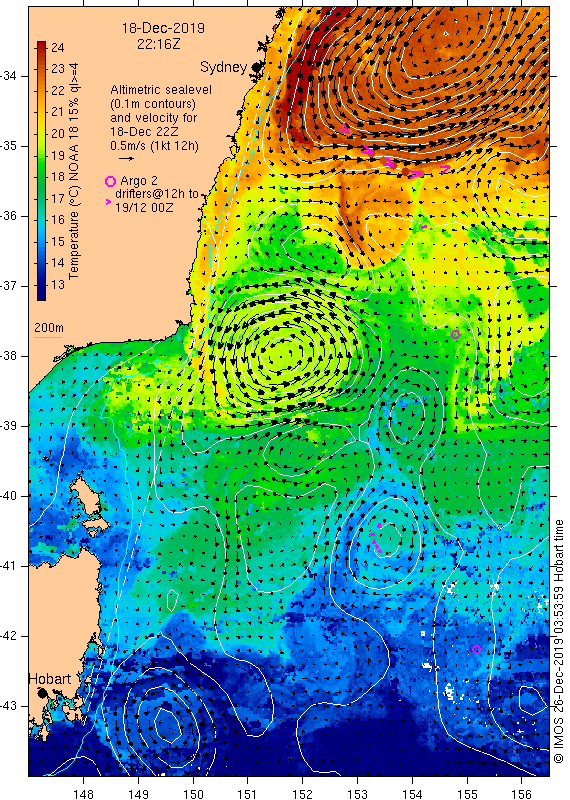Note to Yarns from the Farm readers: this is the fifth instalment of a series on climate change that I’m writing for our local monthly newsletter. The first article is here, the second here the third here, and the most recent here. The image above is a section of the East Australia Current, with temperature contours from satellite data and current vectors derived from a combination of direct observations and models, just before last year’s Sydney to Hobart yacht race.
The title is a quote attributed to President Harry Truman, and a metaphor we often use in conversation. We tend to use the terms heat and temperature interchangeably, but technically they are vastly different things. Your body temperature is about 37 deg C, but the heat you generate in a day to maintain that temperature is perhaps 8000 joules, or roughly 0.1 J/sec.
The global average increase in surface temperature of 1 deg C since the beginning of the industrial revolution predominantly reflects changes in sea surface temperature, since the ocean covers the majority of the globe. The 1 deg C change seems small, and it is in the sense of being able to feel it, or in the context of daily and seasonal temperature ranges.
So, just how does 1 deg C average global temperature change result in climate chaos?
Well, the answer lies in the heat that’s already in the kitchen: the oceans have been absorbing excess heat from the atmosphere for decades, heat that is generated by excess atmospheric carbon dioxide and other greenhouse gases generated in the burning of fossil fuels. The ocean distributes heat both vertically and horizontally through large scale current systems.
Over time, the extra heat from burning fossil fuels has manifested as a small temperature difference at the sea surface. It’s small because water has a huge capacity to hold heat, compared with air, so it takes a lot of heat energy to change water temperature over the full 5 km depth of the ocean by a degree.
How much heat? Well, the estimate is 1 watt per square metre over the past 50 years (a watt is 1 joule per second). Okay, so how does 1 measly watt/m2 cause climate chaos? Well, there are 360 million square kilometres of ocean, which means the ocean has been gaining an extra 3.6 trillion joules of heat energy per second on average for the past 50 years.
Hard to get your head around, isn’t it? The ocean has been absorbing essentially all of the excess heat from increased carbon dioxide ‘solar panels’ in the atmosphere. This heat is now stored in the ocean, so even if we stopped emitting CO2 from fossil fuels tomorrow, the effect will continue to be felt for decades, if not centuries.
Without oceans to absorb the excess heat, the atmosphere would have warmed by an estimated 36 deg C over the past 50 years
The ocean’s main job in weather and climate is to redistribute heat from the equator to the poles. It does this through major current systems (e.g. the Kuroshio, Gulf Stream, East Australia Current).
Heat is also distributed by vertical overturning circulations near the poles, where surface waters become cold and dense enough to sink below the intermediate warmer layers. These overturning cells, though small geographically compared with the great current systems, are vital to moving surface heat into the abyssal oceans.
Schematic of the vertical overturning circulation in the Southern Ocean near Antarctica
By increasing the heat content of the oceans, we have upset the equilibrium of the past few millennia, and the oceans are establishing new ways to redistribute heat. We don’t yet know how the patterns will change: this is the science of ocean circulation modelling, a rapidly evolving field. We’ll talk more about it when we get to future episodes about predicting the effects of climate change.
What we have observed so far, though, are geographic changes in the large-scale current and temperature distributions, reduction in vertical overturning circulations and apparent increases in the severity and frequency of temperature-related ocean phenomena like cyclones.
Unfortunately, we don’t have the option of getting out of the kitchen—we need to use the tools we have to turn down the heat.



